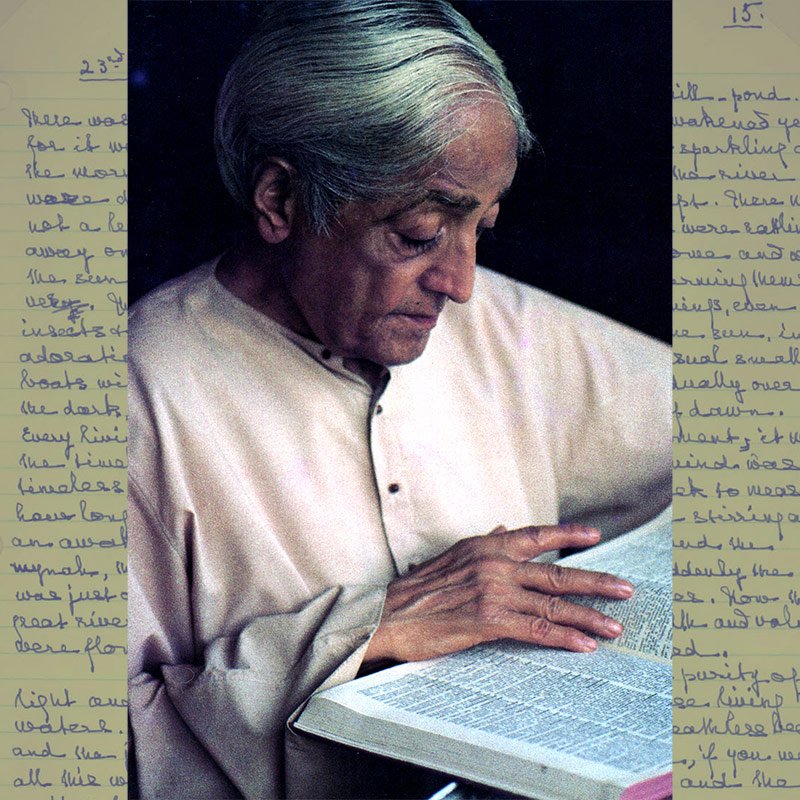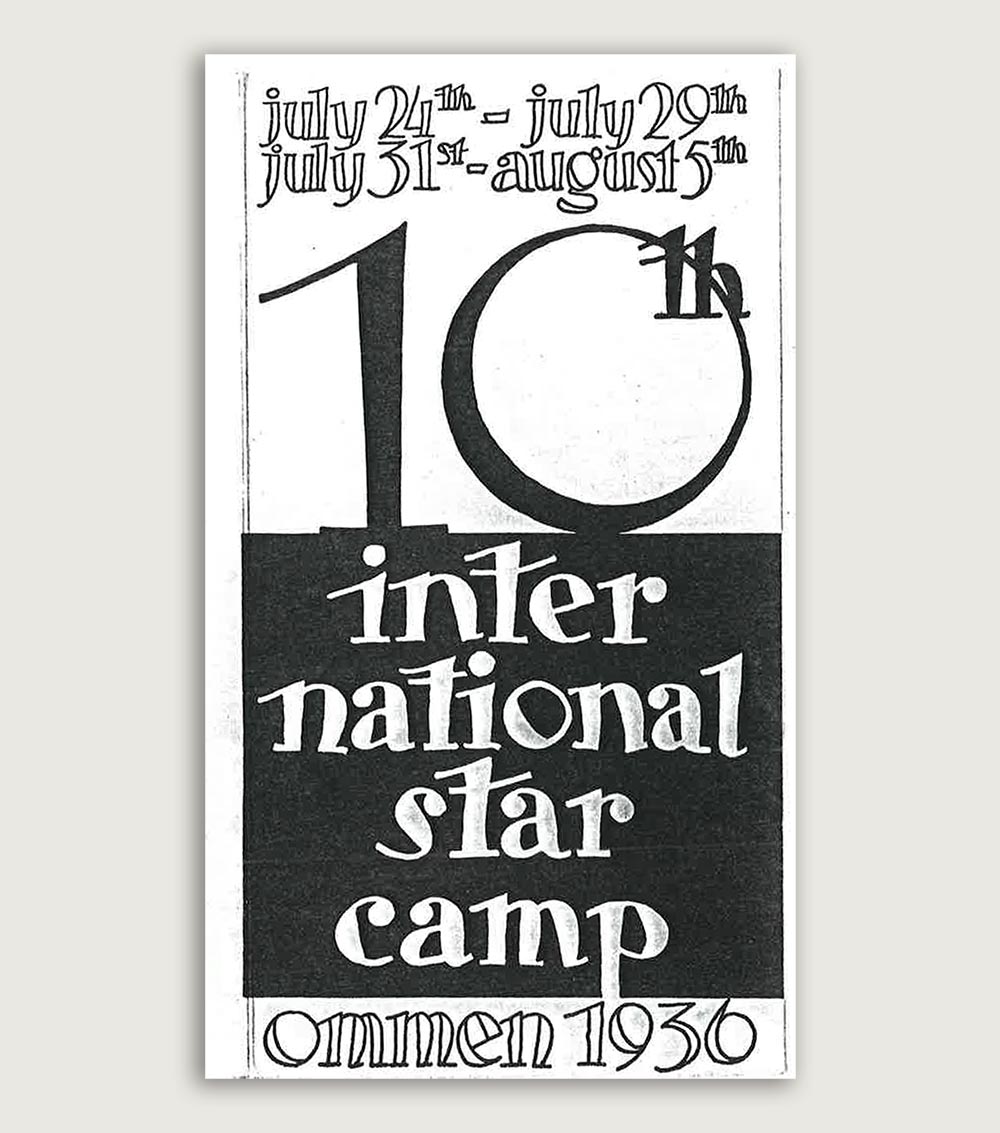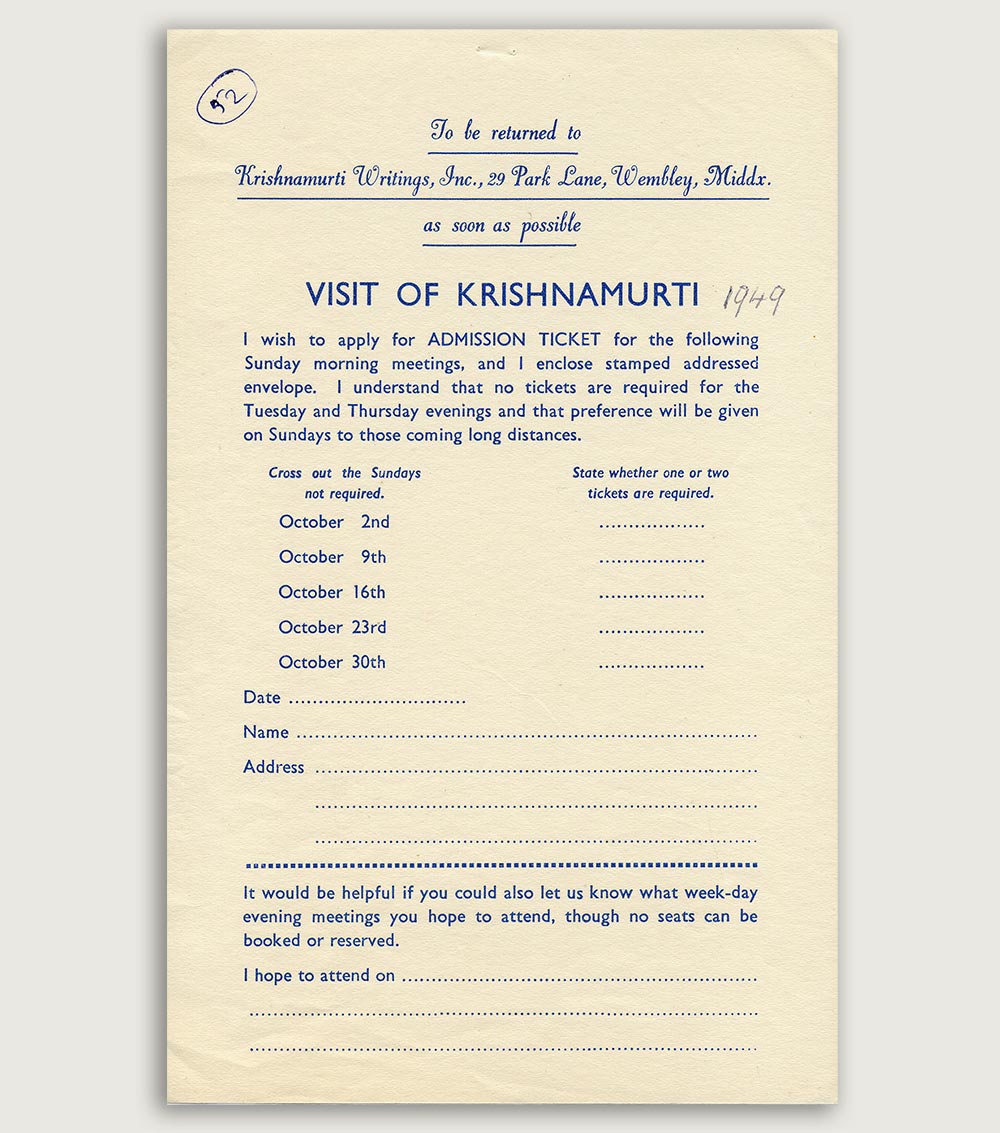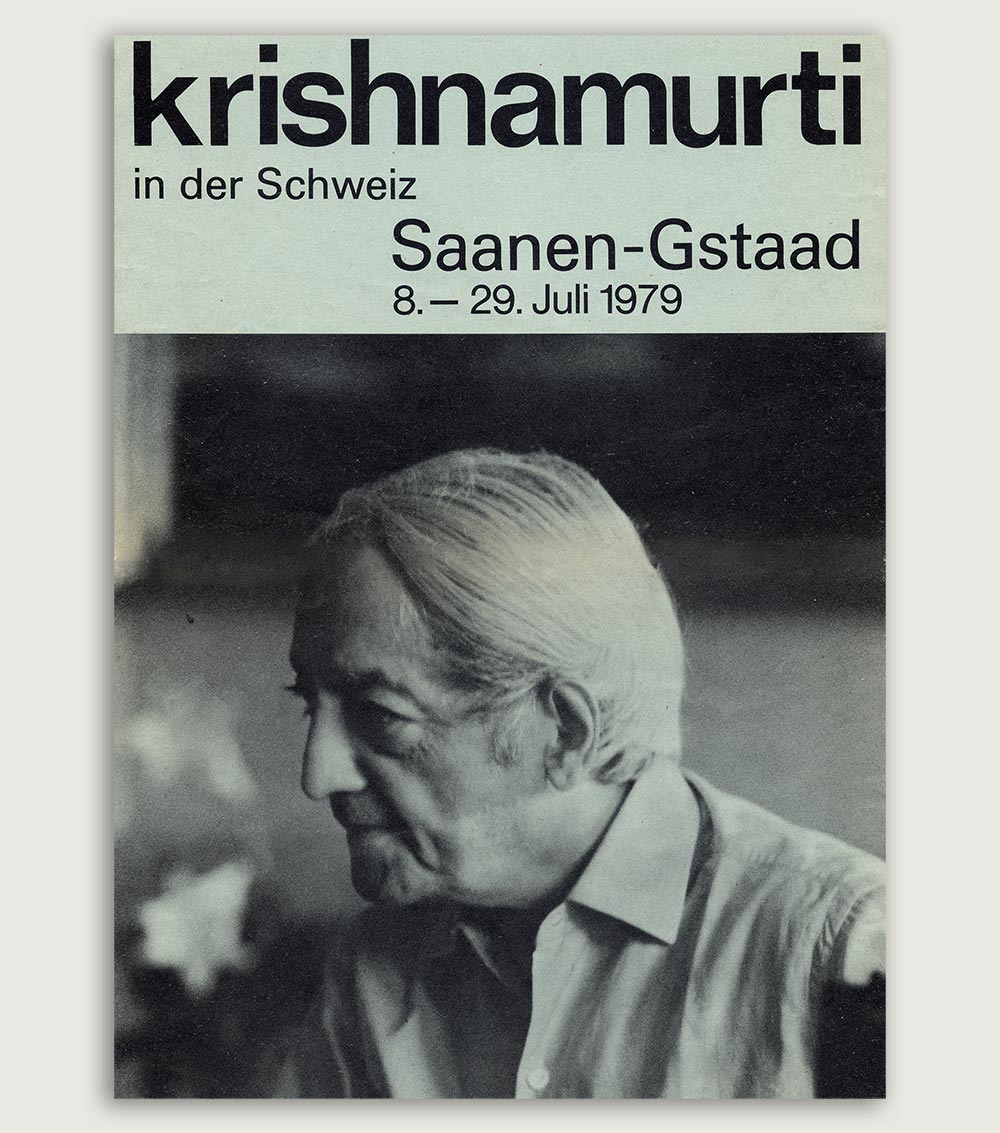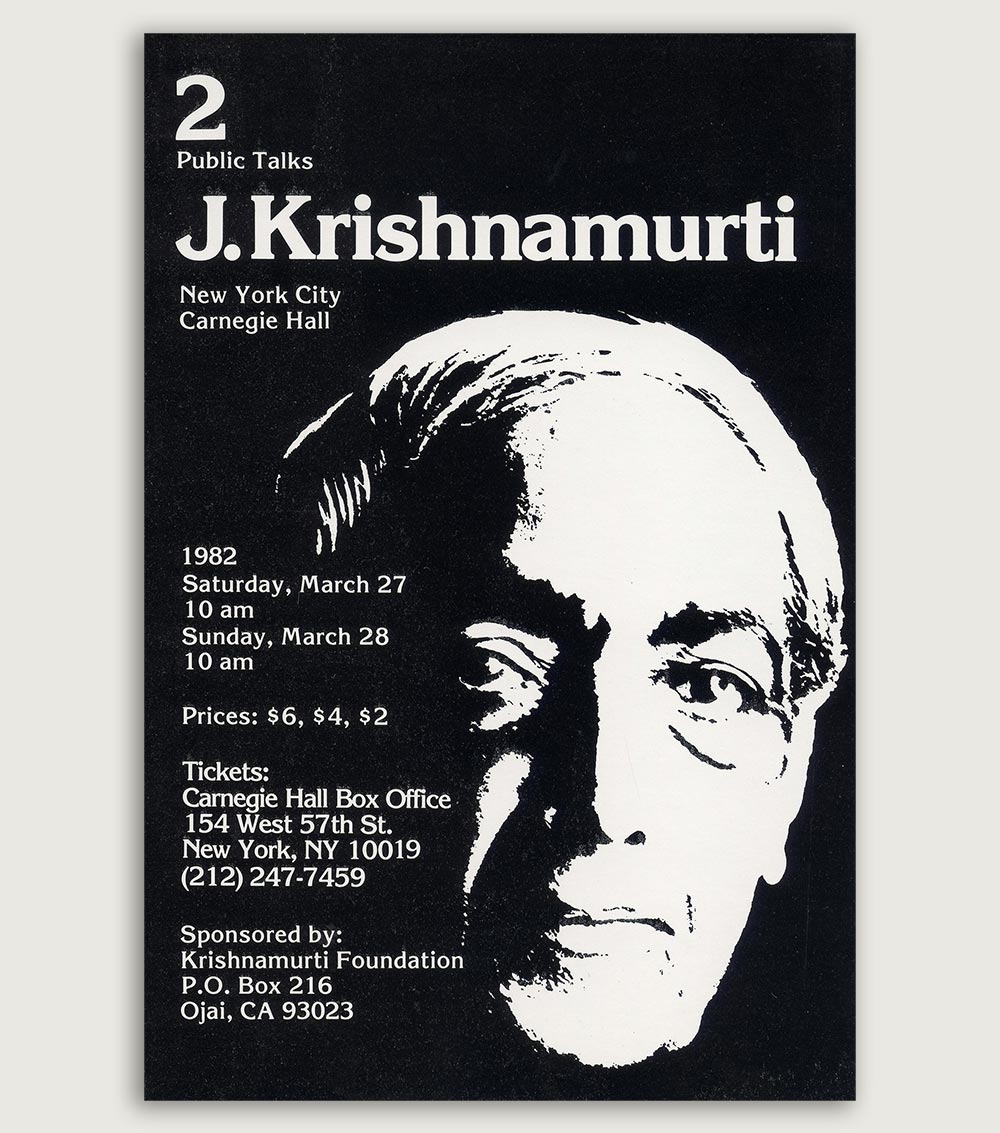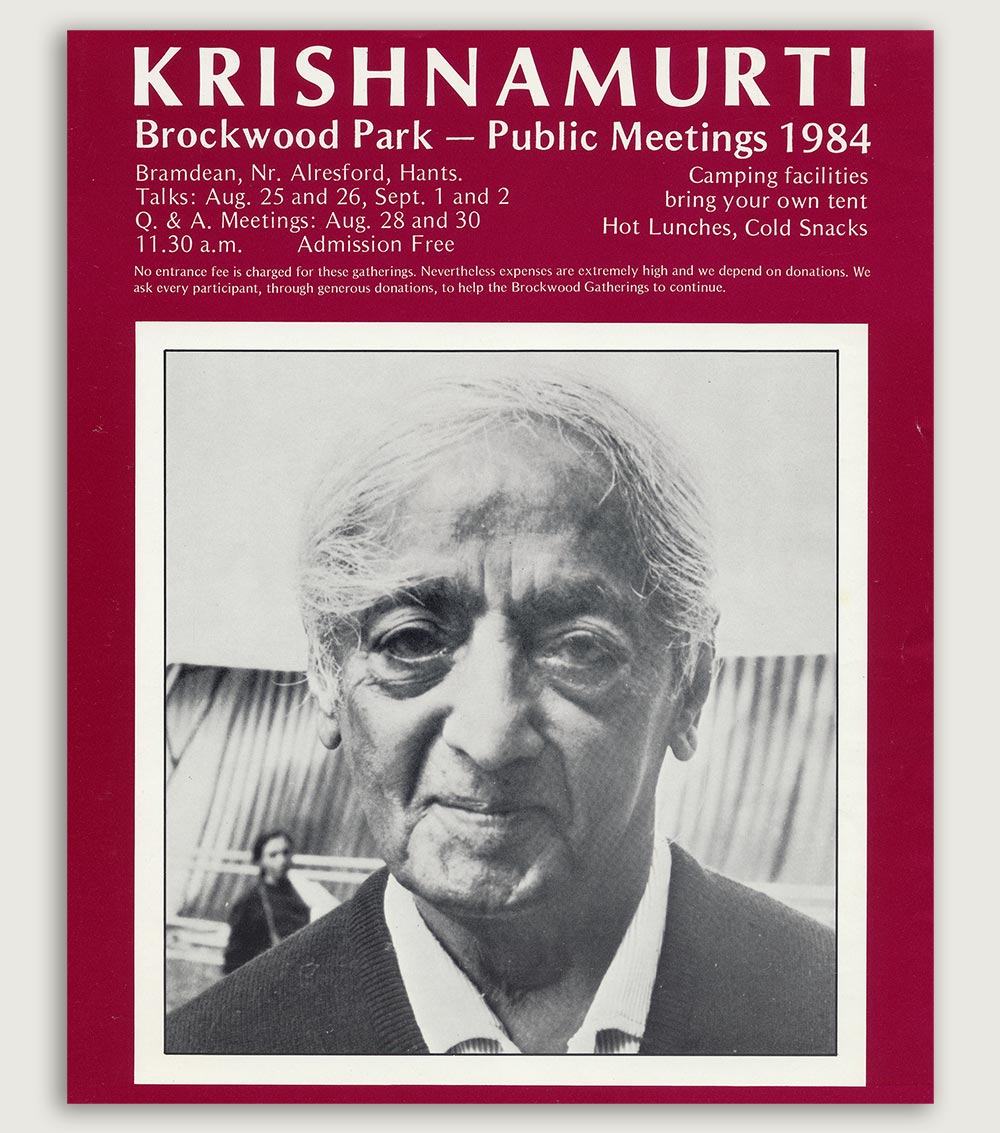During the course of eight decades, from age 15 until just before his death at age 90, Krishnamurti spoke at public meetings, to small groups, to individuals, and to education groups consisting of teachers, parents or students. The first time he spoke at a gathering was in 1910; his final recording was 76 years later in 1986. In total, Krishnamurti held more than 5,300 events. Volume 10 of From the Archives charts the course of these varied events, from the Theosophical era, to speaking in major cities worldwide, to the schools and centres he established, illustrated with contemporary materials and extracts.
The first time Krishnamurti spoke formally was on 23 December 1910 in Adyar, Madras. The then-teenager attended the first meeting of ‘The Order of the Servants of the Lord’. Suddenly immersed in the culture of the Theosophical Society (TS), the first words attributed to Krishnamurti, along with the book At the Feet of the Master that same year, were:
I thank you. I thank you for your love and devotion… My body is young; it does not know this language well, and it is not used to speaking to so many people. I know that your devotion is not to me personally but to the Lord Maitreya through me, so in his name I accept it; for him I accept the position which you offer me. I also will be a servant of the Lord, but it is not enough to be servants; we must be faithful and useful servants.
Through the 1910s, Krishnamurti only spoke a handful of times. It was in the 1920s, with the establishment of The Order of the Star in the East, that Krishnamurti began to speak more often. He addressed ever larger theosophist audiences, at first shyly, even experimenting with speaking from behind a curtain. The talks were in Europe, India and Australia, with his first talk in the US taking place in Chicago in 1922. A typical title was ‘The need of spirituality in the world’, and by the mid-1920s, a common theme was ‘Self-preparation’. Here is an extract from a talk, an example of his language in the early 1920s:
To become spiritual, you must go through the purgatorial period. You must suffer. But to become spiritual, you must desire that more than anything else in the world, give up everything for that Ideal. Learn always to dance on the razor’s edge. Never be content, always struggle. To stop struggling means stagnation and the end of hope. No teaching in the wide world can aid you unless you grasp it firmly, adhere to it, stand by it. – Krishnamurti in Los Angeles, 1923
From 1926, with Krishnamurti now in his 30s, the frequency of talks increased further. His audience was still mostly theosophists at conventions, rather than the wider public. However, he did begin to talk to young people in schools, some independent of the TS. In the years ahead of Krishnamurti’s famous speech in August 1929, when he dissolved The Order of the Star, his talks increasingly challenged traditional theosophical notions such as spiritual hierarchy, progression and initiations – which culminated with his saying:
I maintain that truth is a pathless land, and you cannot approach it by any path whatsoever, by any religion, by any sect. That is my point of view, and I adhere to that absolutely and unconditionally. Truth, being limitless, unconditioned, unapproachable by any path whatsoever, cannot be organised; nor should any organisation be formed to lead or to coerce people along any particular path.
Despite his split from the TS, Krishnamurti in the 1930s continued to hold talks and gatherings in many of the familiar locations, particularly the Ommen Camp in the Netherlands and in Ojai, California. Ommen continued to be a major venue until World War II. He also travelled more widely, visiting various cities from Scandinavia to Chile to New Zealand.
You cannot segregate yourself from the world, from life, and withdraw into a monastery to contemplate what consciousness is, because it is only in the process of living that you discover what it is. If you are merely increasing consciousness as individuality, without comprehending it, you are creating more and more sorrow, limitation, self-sustaining poison, and therefore preventing the true comprehension of consciousness. – Krishnamurti in Ommen, 1936
After a pause due to restrictions during the war, Krishnamurti resumed his travel and talking schedule with renewed vigour. The talks from 1945 to 1960 represent some of his most powerful and energetic. Firmly established in his own voice, and completely free of theosophical terminology, he began to establish an annual pattern of travel, visiting India through the winter months. He also gave many private interviews in between the public events, which formed the basis of books such as the Commentaries on Living series. In addition, small group discussions were also held, which had begun in the 1930s. These provided a more intimate setting for nuanced questioning.
Simplicity comes into being only with the process of understanding the complex ‘me’, the structure of myself. The more I understand, the greater, the wider, the deeper that understanding of ‘what is’, the greater the freedom from conflict and misery. And it is this freedom that brings simplicity. And therefore the mind is quiet, no longer crowded, pursuing. As a pool is quiet, the mind becomes quiet; all the process of effort is understood. And with the quietness of the mind, the timeless comes into being. – Krishnamurti in London, 1949
In the early 1960s, Krishnamurti began holding public meetings in Saanen, Switzerland. This became the major venue for his European talks in the summer each year. From 1969, this venue was complemented by the meetings at Brockwood Park each September.
To investigate, you must be free. You must be free to examine; you must be free from the blocks that impede your examination. The impediments are your prejudice, your experience, your knowledge and other people’s knowledge – all those act as impediments; then you cannot possibly have the capacity to examine or think together. The speaker has none of these problems: he has no prejudice, no belief. Finished. Only if you are also in that same position can we meet together. – Krishnamurti in Saanen, 1979
The late 1960s saw Krishnamurti reaching new, younger audiences, with the new cultural movements that developed in the West during that decade. He was invited to speak to student audiences at universities on the East and West coasts of the United States. He also spoke in cities such as San Francisco and New York. Scientists and psychologists began to be interested in his work, and a new format was introduced: seminars. With attendees from religious scholars to quantum physicists, these meetings proved Krishnamurti’s versatility and ability to communicate his universal teachings no matter how specialised in their fields the participants were.
Only with ending is there a new beginning. That is, when you are attached to something, a person, an ideal, an experience or an invented idea, that attachment brings about its own contradiction. Whereas there is an ending to attachment completely, there is a totally different movement, a different dimension free from attachment. – Krishnamurti in New York, 1982
With the foundation of Brockwood Park School in the UK, followed by The Oak Grove School in California in 1975, along with the schools established in India, Krishnamurti was able to further engage with educationalists, parents and students throughout the year. These schools became a principal focus for him through the 1970s and 80s, challenging traditional forms of education and the conditioning of adults and students alike.
Where there is this self-centred outlook on life, life being so extraordinarily vast, that limited outlook, that limited way of living must inevitably bring sorrow. And is there an ending to sorrow? Complete ending. Without ending sorrow, there is no love. – Krishnamurti at Brockwood Park, 1984
In the 1980s, Krishnamurti was asked to speak at bigger and more prestigious venues. He was interviewed more often for television, radio, newspapers and magazines. Despite now being in his late 80s, he also continued his rounds of public meetings, small group discussions, conversations and seminars. His very last talks were at a location very similar to his first, at Adyar in Madras. Rather than the TS, the talks were organised by Krishnamurti Foundation India, one of the four foundations that were established in the late 1960s and early 1970s. In contrast to his earlier life, these organisations have no spiritual authority and are for the sole purpose of preserving and making these many events available in their authentic form, now and into the future.

